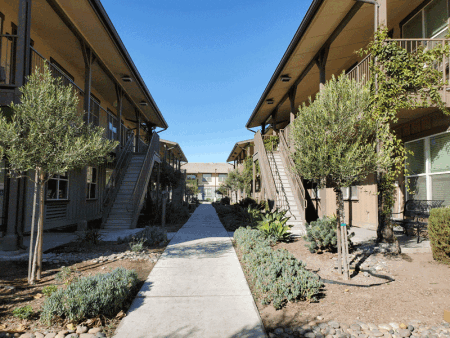
Oregon’s Farmworker Housing Development Corporation’s Colonia Unidad consists of four low-rise apartment buildings that will provide affordable housing to serve farmworkers, the workforce population, and their families. The project aims to provide residents with a safe, healthy, and comfortable place to live, and provide a lasting and identifiable place to call home. (Joshua James Huff)
Affordable housing challenges are not limited to urban centers or technology hubs. Smaller towns often struggle to house their workforces and—perhaps less noticeably, but no less acutely—so do agricultural operations. Agriculture employs 11 percent of the U.S. workforce, while also contributing to manufacturing, wholesaling, and retailing. The sector is also suffering from a dire labor shortage that has the potential to disrupt the entire food chain.
A number of factors are contributing to this shortage, but housing has emerged as a fundamental requisite—not only for H-2A labor (the seasonal guest worker visa program requires employers to provide free housing and transportation for H-2A workers), but as a critical tool for recruitment and retention of both domestic and immigrant workers. Without certainty around their ability to harvest, pack, and process, it makes no sense for farmers to expand production. The result of a noncompetitive U.S. agriculture sector will be increased imports, higher prices, and reduced national food security.
Too often, agricultural worker housing lives up to a substandard, labor camp stereotype. Given the inadequate inventory of affordable multifamily real estate in rural areas, farmworkers have historically been packed into obsolete motels or houses in working-class neighborhoods. However, as the costs of increasingly scarce labor have skyrocketed, employers are recognizing that the provision of decent housing is critical to their bottom line, whether or not legally mandated by immigration law.
Agricultural Worker-Only Housing
Individual agricultural workers (i.e., those not living or traveling with family members of their own) often represent a seasonal component of the workforce and are typically housed in dormitory-style accommodations; that is, four to eight people occupying a unit with shared kitchen, bathroom, and living area. Ideally, this type of housing is located on or close to the worksite; however, where precluded by economic factors, zoning, and/or community concerns, workers and employers (at least for their H-2A employees) are obliged to find housing in constrained rental markets.
Houwelings Group, a leading North American greenhouse grower, has seen firsthand the benefits associated with on-site workforce housing, as well as the impacts of a lack thereof. The company’s Delta, British Columbia, facility employs both domestic and migrant workers as part of year-round operations. Its ability to house migrant workers on site, in comfortable, modular units, has been key to its ability to retain skilled labor; Houwelings has consistently employed some of the same experienced workers for upwards of 10 years. In contrast, and despite numerous attempts to mitigate unfounded local objections, Houwelings’s Utah facility has had to rely on a more remote network of rental properties to house workers, making daily transportation costly, inefficient, and a contributor to negative externalities like traffic and greenhouse gas emissions. Community opposition has stymied a number of on-site and proximate agriculture housing proposals with examples including one put forward by a large-scale dairy in Oregon and another by a Colorado greenhouse producer.
An oft-referenced example highlighting the benefits of on-site worker housing is that of lettuce producer Tanimura & Antle’s (T&A) Spreckels Crossing development in Salinas, California. In 2015, for the first time in decades of production, the company faced a severe labor shortage. Recognizing this at least partially reflected issues with a lack of housing, the company set out to find a solution for what was assumed to necessarily be an H-2A labor force. Several advantages allowed T&A to move quickly; on-site land was available, and infrastructure was in place, as were approvals for agriculture-related housing use. These factors eliminated obstacles associated with public approval and funding, as well as onerous California Environmental Quality Act (CEQA) reporting. In 2016, the $17 million, 100-unit Spreckels Crossing project was completed, with a capacity of 800 T&A employees. To the company’s surprise, its housing offering incentivized a 100 percent domestic workforce, the modest affordable rent which covers operating costs. T&A Vice President Wesley Van Camp stresses the company’s sincere belief that “keeping experienced workers employed and affordably housed is the most impactful thing we can do for our business.” In the years following the completion of Spreckels Crossing, T&A has employed its most productive crews ever. While the project was not without detractors, substantial outreach efforts helped alleviate community objections and garner public-sector support, the latter bolstered by a keen government awareness of the importance of agriculture as an economic driver in Monterey County.

Located on the same property as Tanimura and Antle’s main office, our Spreckels Crossing housing facility consists of 100, two-bedroom, two-bathroom fully furnished units. The employee-only residential housing complex has the capacity to accommodate up to eight employees per unit; though if preferred, they have the option to rent a room with fewer occupants. (Tanimura & Antle)
Agricultural Family Housing
Affordable housing for permanent farmworkers with families is also needed, particularly in California, where the most productive agricultural geographies in the United States overlap with those considered highly desirable by affluent residents, and where real estate pricing is far beyond the reach of the workforce on the other side of the proverbial “lettuce curtain.” Housing agricultural worker families dictates a different type of product versus the dorm-style one previously outlined, one with large units and a wide range of amenities and services such as child care, education, health care, recreation, and community integration programs.
This type of housing also involves different development strategies and funding sources, often depending on the support of nonprofit orgnizations and the public sector. Expert knowledge of available grants, subsidies, and incentives is critical, as is the ability to coordinate complex capital stacks. Although it is less common for agricultural employers to build family housing, several nonprofits report inquiries from large-scale California growers regarding permanent workforce housing development and property management assistance. It should be noted, however, that public funding is not always available for seasonal H-2A labor.
Eden Housing and Midpen Housing are examples of nonprofit groups focused on providing affordable family housing in the Bay Area, including geographies where the local economy is dominated by agriculture, e.g., Monterey and Santa Cruz counties, and coastal San Mateo County. Projects like Eden’s Camphora Apartments, a $21 million, 44-unit, Section 8 development in Soledad, California, have successfully added high-quality, service-enhanced, sustainable housing options; however, they have also had to overcome significant construction cost and financing challenges. Camphora was funded by no fewer than a dozen different sources. The use of public funding triggered prevailing wage requirements, exacerbating already high costs stemming from the need to install water and sewer infrastructure under a major highway. U.S. Department of Agriculture dollars were returned because they came with burdensome compliance regulations around the legal status of all household residents. Camphora did enjoy strong support from Monterey County, which had been trying to find a way to rehabilitate the site—formerly a blighted cinderblock labor camp—for decades.
Likewise, in Oregon, the Farmworker Housing Development Corporation (FHDC) has benefited from long-standing relationships with local jurisdictions, as well as with Oregon Housing and Community Services (OHCS). FHDC’s recently completed 44-unit Colonia Unidad project in Woodburn is notable for its hybrid model, oriented to agricultural workers as well as a broader low-income workforce demographic. Not only does this allow families to seek employment outside of the farming sector, it facilitates the integration of farmworkers into the broader community. In addition to positive civic impacts, projects such as Camphora and Colonia Unidad generate economic benefits via more productive, stable agricultural workforces. They also recognize, per one Colonia Unidad resident, “the importance of agricultural work; without it, there would be no fresh food on our tables.”
Making Agricultural Housing Projects Work
A number of common factors have contributed to the success of these and other agricultural housing projects, including the following:
- Public sector and community support. This is particularly critical where housing development requires land use changes. Pioneers like T&A’s Van Camp cannot overstate the importance of early education and outreach. Her success in pivoting the Spreckels Crossing conversation from safety and crime concerns to one of local economic benefits and American pride was based on connecting the project to the retention of domestic jobs, wages, and spending power (admittedly an argument less easily made for H-2A workers).
- Employer support. Agricultural employers are becoming more keenly aware of the value of a stable, productive workforce. Clear links to an improved bottom line should incentivize additional producer interest in the provision of housing solutions.
- Lessons learned from these projects will continue to pave the way for additional development. Spreckels Crossing served as a blueprint for the Nunes Company’s Casa Boronda, a 75-unit Salinas project built for seasonal agricultural employees. It got overwhelming city and county support; the hope is that it will become a model for the nation’s agriculture industry. Eden Housing will apply lessons learned from Camphora to its next agricultural housing project in Watsonville, while the FHDC is using Colonia Unidad as a stepping stone for its planned project, Colonia Paz, in Lebanon, Oregon.
- Cost control. Where possible, financial feasibility can be boosted and construction costs mitigated with siting that uses existing infrastructure and structures, and that already has the appropriate zoning in place (e.g., rehabilitating motels and older multifamily projects). Modular housing can also improve project economics and timeframes, as was the case with Golden Fresh Farm’s on-site housing in Wapakoneta, Ohio.
- Green building initiatives can lower operating costs and generate tax credits. Camphora received LEED-H Platinum certification and was designed to exceed California energy efficiency thresholds by incorporating features such as a large solar photovoltaic system. Per Eden’s president, Linda Mandolini, “solar just makes so much sense in this part of the world.”
Unfortunately, even the most thoughtful attempts to learn from these lessons can fail. Despite the documented labor shortage and clear ties linking farmworker stability and well-being to a more productive, profitable, and secure domestic agriculture sector, housing development continues to face significant barriers. Just how much economic pain it will take to force stakeholders into enabling versus impeding housing production remains to be seen. This sentiment, shared by Houwelings’s CEO, Kevin Doran, resonates, “If we don’t make it easier for Mexican workers to come here, our farms will go to Mexico.” This reality can just as easily apply to the need to make agricultural work accessible for all workers, the alternative being to compromise our nation’s food security.
KIMBERLEY PLAYER is a ULI member and currently the director of research at Equilibrium, where she develops sustainable real asset investment strategies, with a focus on housing and large-scale agriculture, food, and infrastructure operations.



